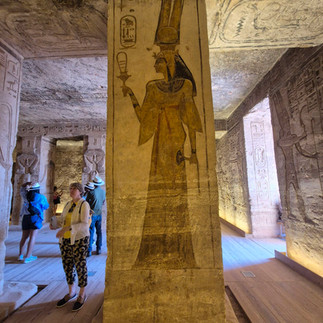Egypt 2025 Post 6 Into the tropics!
- Anne B 10milesfrom
- Mar 22
- 6 min read

Penultimate post! We had arrived in Aswan during the night. Aswan is another ancient city which has roots dating back to ancient civilisations in Neolithic times. This is the old land of Nubia which covered southern Egypt and North Sudan and is close to the so called 'cradle of civilisation'. John had told us we must be ready to leave at 4.30 am - eek. As we drove through the city there were a surprising number of people about. 4.30 is the time of prayers, and after these prayers faithful muslims must fast until the sunset prayers around 6pm. We now had a 3 hour drive south through the desert to Abu Simbel.And this really is desert!

Head west for 3000 miles and it is sand all the way to the Atlantic! Head east and it is the deserts of Saudi Arabia. We go south and cross the Tropic of Cancer and finish up just 30 miles from the Sudan border! When the Aswan dam was built it created an incredible lake behind it, stretching into Sudan. Lake Nasser is 340 miles long!! Even so, the Nile floods are so huge that they needed to build giant spill ways to siphon off the excess water.
One down side of the dam is that while it has provided a great source of water for drinking and irrigation, and has limited the damage done by floods downstream, it also means that the nutrient rich silt no longer covers the flood plain each year, so artificial fertilisers etc must be used.
Why were we travelling 3 hours to Abu Simbel? Two incredible temples are located here, which are very different from any we have seen so far.

Built around 1265BC, they are dedicated to Ramses II and his wife Nefertari. Both temples are carved directly out of the sandstone cliff face, which must have been an incredible feat, especially as the larger one goes more than 35 metres back into the hill. However, equally remarkable is that when the Aswan dam was being built, they knew these unique temples would end up underwater once Lake Nasser formed. So, in a project jointly run between Unesco and Egypt, every part of the surrounding hill and the entire temples was mapped, numbered and cut into sections. Then it was all moved and reassembled 220 metres higher up the hill. The project took 10 years to complete. We felt this was as astonishing as the temples themselves, and all well worth the drive!

The smaller temple is dedicated to Queen Nefertari, and is guarded by 2 large statues of her, and 4 even larger statues of Rameses II himself! This man is so vain. We must have seen hundres of statues of him on this trip, most of them huge! The Queen's temple contains chambers, pillars and wall art, much of it dedicated to God Hathor with the cow ears or horns. Queen Nephertari is shown as slim and elegant.
The Great temple is vast in comparison. 4 colossal statues of Rameses guard the outside. Then 8 more line the inside!

This temple was built immediately after a war with the Hittites, and it was meant to make a statement! Huge scenes commemorating the battle of Kadesh are on the walls.


The pillars and statues are very well preserved
There are many side rooms with images of offerings.
Incredibly, this wonderful ancient monument was full of swallows building nests.. slightly worrying due to the corrosive nature of guano!!

The sanctuary is unusual because it still contains the statues of the Gods, carved from the solid rock and so immovable.

There are four statues... God Ptah, the God of Darkness, Amon-Ra, God of sun and creation, Ra-Horakhty, the God of the Sun and the air, and one more. Guess who? Rameses II who promoted himself to God status! The large temple was built so that on the 21st February and 21st October (thought to be Rameses II birthday and coronation days), the sun would shine straight in through the main door and illuminate 3 of the statues far inside. But never Ptah because he is the God of darkness. When they moved the temples they aimed for the same alignment, but ended up just 1° out, and therefore one day late, so it happens on the 22nd of both months now and is called the Festival of the Sun. The door to the temple is locked with a super Ankh key.

This is the view from the door of the temple

Then we drove back! The desert is so barren, but an artificial irrigation project using water from Lake Nasser means that at one site a huge area here is now farmed for fruit and vegetables. Otherwise there is nothing except a few military installations, very vibrant weeds and bus stops apparently in the middle of nowhere!
There are a few service stations....

Once back we had a few hours gap, and then John had arranged a private Felucca ride. These are an ancient style of sailing boat with one sail split in half horizontally.

Our captain and his crew - Mohammed Ali, were super.


They took us around Elephantine island where Ivory was once carved and traded by the local people, the Nubians. We saw lots of lovely villas, the place where Feluccas are built and local fishermen mending nets.
We also passed the mausoleum of the Aga Khan, and the house of his widow.

As we turned around the island to head back the wind was unhelpful, so we needed to tack back and forth all the way down the Nile to our boat. Even as a reluctant sailor, I had to admit it was heavenly, and the breeze was a welcome respite for 37 - 38°C (98-99°F) temperatures.
A last dinner and a rather strange Nubian entertainment complete with pantomime horse! Or so it seemed!
Next morning check out was 8am. No question of us carrying our own bags, our personal sailor porters did that... I hope our husbands will be continuing the tradition on our return!

A busy morning ahead starting with a visit to the excellent Nubian Museum in Aswan. It contained exhibits relating to Nubian culture from 7000BC onwards. Incredibly detailed and beautiful 5 - 8000 year old drawings and decorated pottery,
Jewellery with a contemporary feel!
an ancient tomb, tomb stone and incense pots
Baskets and olive oil burners - good olive oil was smokeless! A crown, weapons including a leather shield and lovely boat model.
Thumb rings for archers, tubes for black kohl make up which we now know was carcinogenic, and a beautifully inlaid box. Remind yourself these are all between 2,500 and 4,000 years old!!
Oh, and horses! Thankfully these are replicas!

It turns out that for Kings and nobleman their horse would be sacrificed and buried with them wearing this symbolic bridle, saddle and adornments. Hence the horse in the show last night! now it makes sense! The Nubians were sometimes fighting against the Egyptians, and sometimes alongside them, and they were renowned archers.

Their houses were colourful and life revolved around the river.

Next we drove to the Nile lake between the old and new Aswan dams. A boat ride took us to the Temple of Philae on an island.

Dedicated to Isis it used to lie in the flowing Nile river and was a pilgrimage place in a great trading zone. Amazingly this temple was also meticulously divided up into segments and moved to a higher island to avoid the floods. Again this was done by Unesco and Egypt, who relocated many smaller temples and buildings as well.

It still has the stela stone which records details about the founders, architects,Gods, design, dates, building materials etc of the temple!

One of its outstanding features is the Sanctuary which still has it's original altar and very decorated walls.
One thing that frustrated Penny and I was the complete disregard by some of the visitors and guides to the instructions not to touch the monuments!

Another unusual feature was the presence of Christian crosses on some walls and an altar and niche where all egyptian symbols had been erased, showing this was later used as a church. We also found a very Egyptian looking cat!
Another key feature is a large graffiti inscription hailing the success of Napoleon's campaign in driving the Mamluks out of Egypt in 1799.

This beautiful building is Trajan's Kiosk, built in AD98 and never finished. It may have been an elaborate boat house!

Back to the mainland for our final stop on top of the Aswan high dam itself, which was built from 1963 -1973 as a joint Egyptian Russian project. This is their friendship tower.

The dam is a huge curved pyramid, measuring 3.3 kms long and nearly 1km wide at its base, for strength. (Not my picture!)

Apart from holding back the water, it contains 12 huge turbines and generates 10% of Egypt's electricity. Expanding use of solar power means Egypt is increasingly powered by renewable energy. This makes the current president's decision to build a nuclear power station with Russia slightly strange, as is his project to build a new capital city in the middle of the desert. Hmm.
Finally off to the airport and goodbye to our wonderful guide John.

We flew back to Cairo on a somewhat smoggy late afternoon, but could clearly see the Nile below with its narrow strip of fertile land against the barren desert.

Of course we are met at the airport and taken back to our hotel, where we had a nice dinner and a good sleep. Tomorrow is our last day... and we are on our own! No guide! It will be the last diary blog too you will be pleased to hear!



































































































































Comments